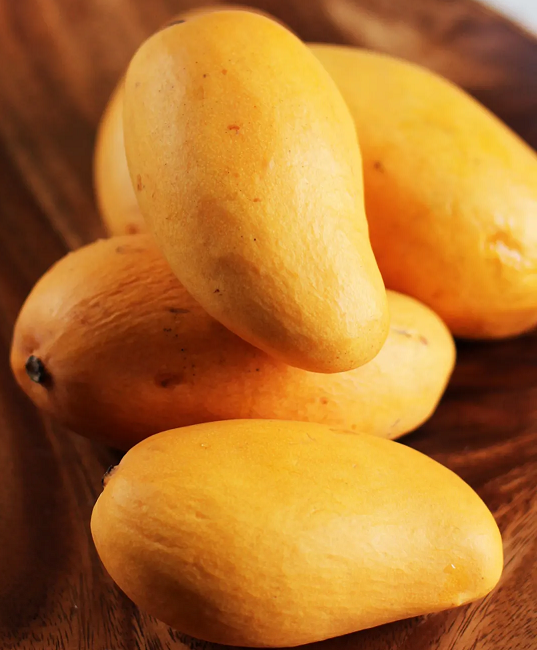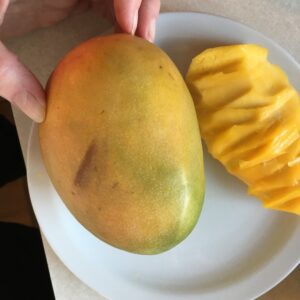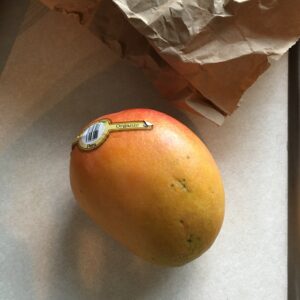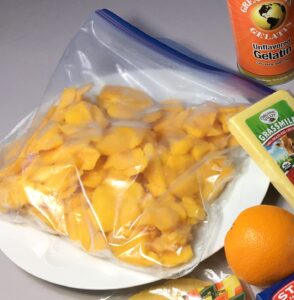Follow this link for more about real foods.
Eating ripened fresh mangos can be a complete treat. I look forward to their arrival every year and they are one of the few foods I’ll completely change my schedule around in order to purchase extra in season and put up in storage for off season.
Mango also has a bit of a cannabis-mango myth reputation. Mangos are often very high in an essential oil like molecule, a terpene called myrcene, which happens to also abundantly be found in cannabis flower, marijuana and hemp types.
Terpenes are the molecules, the chemicals in plants responsible for fragrance and taste. These terpene chemicals can also sometimes behave like nutrient supplements and produce certain effects in the body.
There are hundreds of different terpenes found growing throughout the plant kingdom including those growing as part of the mango fruit and those growing as part of the cannabis flower. Myrcene is only one of these terpenes.
The terpenes found in cannabis in particular can sometimes enhance various healing or other properties of the other cannabis compounds like the cannabinoids of THC and CBD.
Some “full spectrum” cannabis products specifically have certain terpenes added back into those formulations to enhance certain characteristics of the formula.
Some people (told anecdotally), when consuming certain terpenes in combination with THC cannabinoids, have said they felt more high– more dizzy, more relaxed, more paranoid, more couch-locked sedated, etc. But which specific terpenes out of the hundreds? And what specific amount of terpenes against what amount of THC? Anyone’s guess.
And there is a mango theory people have talked about that says the myrcene terpene in the mango, if the mango is eaten a little before consuming THC-rich cannabis, can increase the experience of being high from the THC.
I have heard that some terpene-rich cannabis flower, even with very very low concentrations of THC can cause some people to feel more THC side effects like the psychoactive, dizzy, high effects.
But all that said, in my opinion this “eat a mango before consuming cannabis to feel more high” is just a myth.
Why? Terpenes are also very fragile. They evaporate quickly from harvested plants, especially if not stored properly (including cannabis flowers, including mangos). They also lose their additive properties at low temps.
They are what make essential oils have fragrance and other properties. And they are as fragile as essential oils. I like to equate terpenes with essential oils.
So unless cannabis is inhaled (more specifically by low-temp dry vaporizing a cannabis bud), there is a good possibility there are no terpenes, or not the correct amount of terpenes present in a cannabis formulation (or even a joint that was lit on fire) that was otherwise heated to activate cannabinoids, like THC, at much higher temperatures than terpenes, which were then destroyed in the process.
So usually the terpenes are no longer even present in the formulation products or the cannabis smoking pre-rolls and joints.
And even when inhaling a cannabis flower, one might have been given some lab certification upon purchase of the bud showing some tiny-tiny percent of myrcene (along with maybe 20 more terpenes) that was detected from a submitted flower sample after harvest, but what is actually left in even a premium cannabis flower bud by the time it will be smoked or inhaled is anyone’s guess.
And as far as other cannabis products, edibles, oil tinctures or butters or salves etc. well, the terpenes are long gone there too, unless the commercial product manufacturer added them back into the mix, like adding a bit of essential oil into a food prep, before packaging the product. And who knows how much myrcene (and still balancing such a delicate amount to not overwhelm in undesirable taste or fragrance) is left in such a product.
So I instead suggest eating mangos as the delectable dessert-like fruit they are and enjoying them straight up, neat, for breakfast and lunch!
And leave the mango/cannabis experiment for others since that would be a recreation experience and possibly dangerous.
I consume (homemade only) fresh or frozen or reconstituted dried mango, about 2/3 cup (or one mango) per day, 7 small mangos a week, I like best the orange Ataulfo ones from Mexico.
It needs to be ripe, sweet, soft fruit and definitely NOT crunchy!
These Ataulfo mangos are sometimes marketed as “Champagne mangos” or yellow mangos, and are the darker yellowish-orange color, non-round, they form around a flat pit. Ataulfo mango type is not stringy. When ripened, it has a rich, sweet taste. If not quite ripe, it will be “sweet-tart” like.
Also not stringy, and having a flat pit the mango forms around, is a “green” mango (not meaning “unripe” but the type of mango is sometimes called Green). Most of it should look orange, maybe some red, with a very light green area on the skin at its base (darker green when it needs more ripening). It’s ripe when most of it looks beautiful orange, sometimes with speckles, maybe still a bit of red and little to no green left on the skin areas. The inside fruit should be a beautiful shiny, juicy darker yellow to orange color.
Some of the Red named mangos (which are often used for the dried mangos in commercial packaging) can have “fur” through the fruit that is textually displeasing and their pits are round and fat taking up more of the fruit weight instead of the fruit. The outer skin is usually mostly red that stays red with some green areas. The fruit can be yellow or orange. If ripe, the fruit should still be shiny and really juicy.
When purchased in season, the mangos will have few blemishes inside or out. They should be larger, slightly indent when pressed (don’t buy rock hard ones), heavy.
Some of the mangos can present areas of white “woody” like fibers in some of the fruit inside areas when peeled or cut into that can be cut out or cut around if not too large. This blemish is more pronounced later in the season. It does not affect the rest of the mango in taste or any way if it can be cut around or cut out.
Mangos can be purchased in larger quantities to freeze, or enough for two weeks of fresh eating at a time without worry you need to work with them right away. They generally take a couple days to a week to ripen. Left in a closed paper back for a few days they can ripen to perfect sweetness.
Once ripened, they can be stored in the refrigerator for a good week.
A ripened mango should feel heavy, slightly soft when pressed, the Ataulfo mangos will have darker yellow-orange skin that becomes just ever so slightly wrinkled. The fruit inside should be darker yellow-orange, shiny, juicy.
Mangos that are hard, or have light yellow or crunchy fruit may never ripen, even in a bag. They are often tasteless and could irritate IBS symptoms. Eat ripened fruit whenever possible. If fruit does not ripen in a few days in a closed paper bag, it was most likely picked out of season or too early off the tree.
To my knowledge, most mangos are not yet GMO.
In the US, they can be found imported from Mexico starting the end of March through July and August.
Freeze-Fresh-mango
HACK: If you have extra freezer space, you can consider doing as I do and buy extra during the late spring to put up and have to eat during the off-season.
Peel and cut them into slices onto cookie sheets with parchment paper put down on the tray and freeze the tray for 3 hours, and then pour the almost frozen solid pieces into a gallon sized plastic freezer bag to store longer term and freeze the rest of the way.
The best time to put up mangos for the off-months is very early in the season. I get mine for freezing around the 3rd week of March until mid-April.
The mangos are bigger, less blemishes, easier to ripen. I use 9 of these mangos per cookie tray, sliced/cut up to freeze. Each gallon bag of 9 then is enough for usually two weeks of eating during the off season.
I use nitrile gloves to work with these. I get better grip (a ripened mango is juicy) and less chance of nicking myself slicing up a number of these. And my nails don’t turn orange!
Use a sharp paring knife and pare them like you would pare an apple peeling in a spiral. Potato peelers can sometimes work but they usually don’t bite into the skin well enough if the mango is actually ripe enough with the slightly wrinkled skin.
Hold the peeled mango in your hand with the larger bottom end of it towards your body. Cut bite-size slices out by cutting the mango in the direction away from you, towards the smaller end of the mango. There is a grain to mangos and the least knife resistance is in this direction. Safer for you too!
If the peeled mango is rather hard, gives a lot of resistance slicing, the mango is most likely not ripe.
Spread out evenly the slices on a piece of parchment paper on a cookie sheet. My pieces are somewhat stacked over each other on the tray.
First freeze timing is critical, SET A TIMER, unless you have a ton of freezer space and can use one cookie sheet tray for only 4 or 5 mangos to spread out more, you don’t want to freeze hard a thick layer like I describe. But if you watch your timing, this amount per tray works great and reduces your work.
I use natural parchment paper on the cookie tray for easy removal of the slices after freezing (wax paper does NOT work, it seems to dissolve under the slices…).
I freeze only 3-1/2 or 4 hours on the tray and then (because they are not frozen solid) I break into some chunks/pieces to put in the plastic freezer bags. If you forget the trays in the freezer and freeze the trays of slices completely, you will end up with a tray of one ice-hard sheet that you can’t get into the storage bag. I recommend you SET A TIMER for the first freeze.
I double-freezer bag each bag and usually freeze about 12 or so gallon-sized bags of fruit like this and it lasts over the winter months.
Alternately, if you have a dehydrator machine, with in season mangos, peel, slice and dry them yourself for storage to be used during the off season. You will have to rehydrate before consuming.
If you buy commercial frozen mango, get the organic ones and be aware they will usually not be very ripe and are often tasteless.
AND often all commercially frozen fruit, as well as dried and freeze-dried, organic or not, can be coated with mag chloride or citric acid (which is NOT vit. C) to preserve the color.
Long term ingestion of these washes that don’t have to be disclosed can cause bleeding bowel and other body damage. So, try it out but don’t lean on anything commercially packaged. Other dried (freeze dried too) fruits and vegetables and even spices have the same problem.
If fresh or self-frozen mangos are not available, try star fruit, cherries, grapes, watermelon, or lychees. (Papaya used to be perfect but it’s all GMO now). Tropical fruit is better than apples, pears or berries. Do not eat pineapple.
Grapefruit is highly estrogenic, avoid it.
The following 5 minute video shows how to know what to look for when you buy a mango, how to ripen, peel, cut up and freeze or dehydrate mangos for eating off season (differently than most internet how-to).






